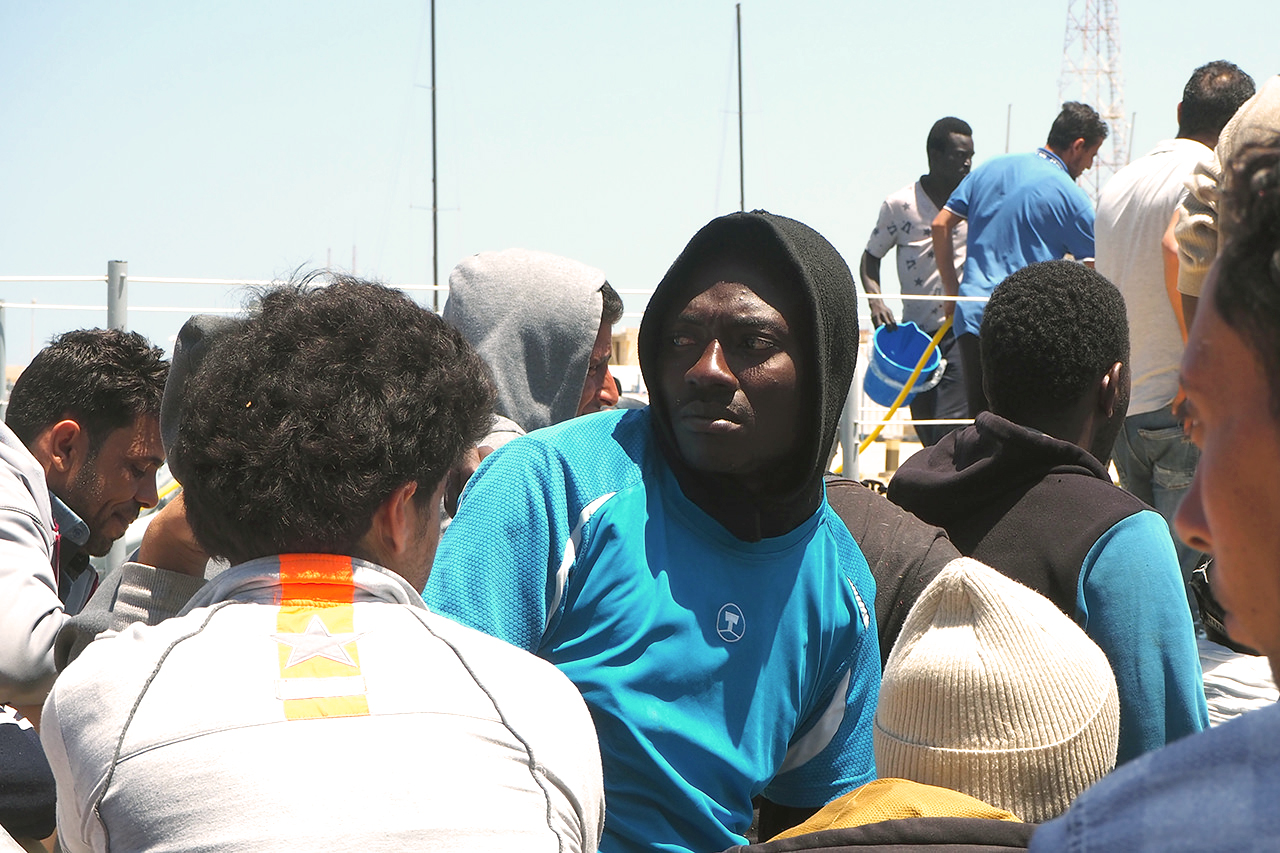As the EU sets new policies and makes deals with African nations to deter hundreds of thousands of migrants from seeking new lives on the continent, what does it mean for those following dreams northwards and the countries they transit through? From returnees in Sierra Leone and refugees resettled in France to smugglers in Niger and migrants in detention centres in Libya, IRIN explores their choices and challenges in this multi-part special report, Destination Europe.
Read the other instalments: Homecoming, Evacuation, Frustration, Desperation, Deportation, Demoralised, Misery and misunderstanding part 1 and part 2, and Overlooked
On the northern side of the Mediterranean, EU officials speak of the success of multi-million-euro programmes that bring fewer migrants to European shores. On the southern side, the Libyan naval Coast Guard is dispirited and struggling to cope with an ever-growing backlog of up to a million mostly sub-Saharan Africans determined to reach Europe.
EU initiatives are credited with dramatically reducing the number of migrants and refugees reaching and attempting to reach Europe by sea from Libya on one of the world’s deadliest migration routes. But Libyan officials say factors within Libya played a greater role, and are calling on the EU to honour pledges of support while warning of a busier summer ahead.
The EU points to a 74-percent drop in migrants and refugees arriving in Europe via the Central Mediterranean route in the first four months of this year compared to last: 9,567 versus 41,165 in 2017. This is proof the new policies are working, EU officials say, noting that the route is largely served by smuggler vessels leaving Libyan shores.
But seven years after the 2011 NATO-led intervention that ousted longtime ruler Muammar Gaddafi and ushered in a period of enduring instability and civil conflicts in Libya, Coast Guard officials here see a very different picture.
Under-resourced and overwhelmed, they accuse the EU of failing to provide enough support and predict any success in reducing arrivals to Europe will be short-lived as it is more down to changing local factors than EU policy-making.
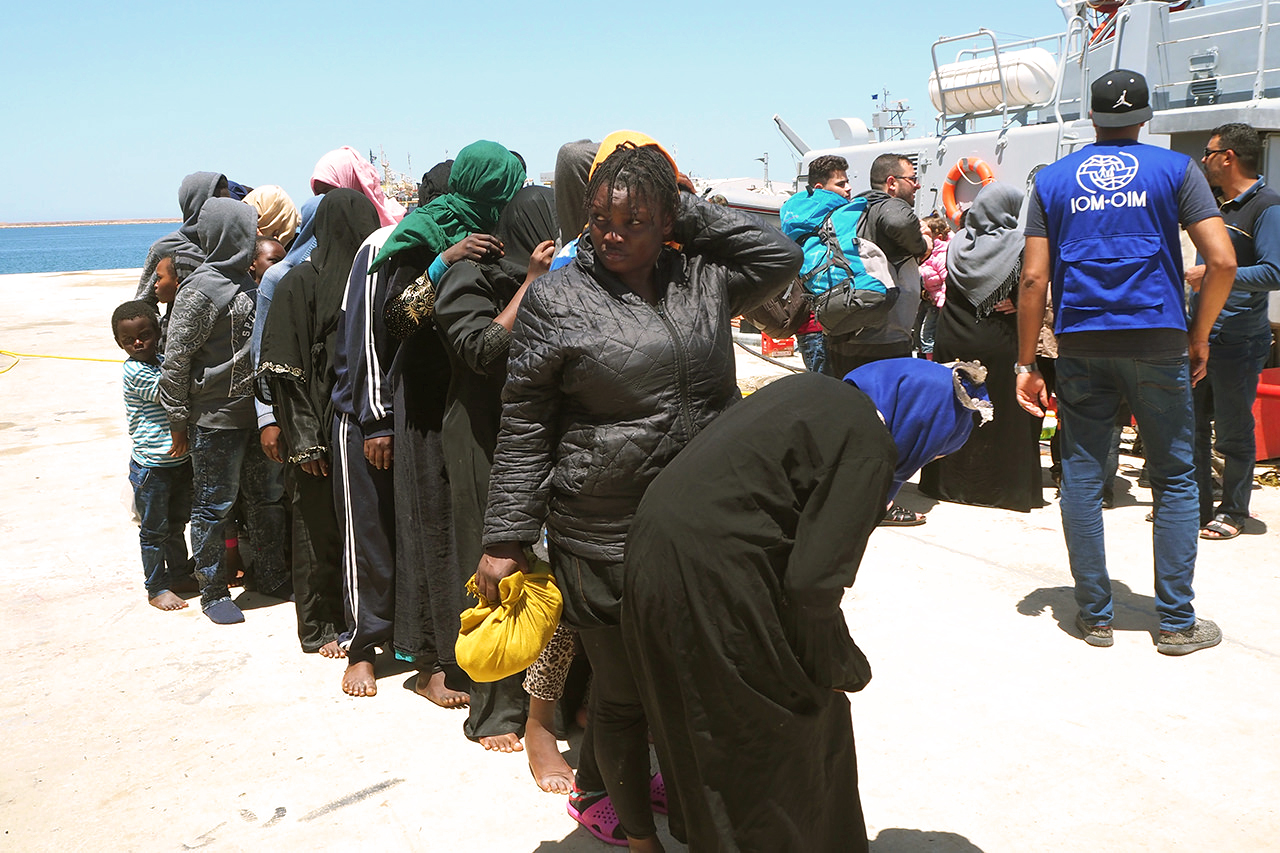
“We’ve had endless meetings with EU representatives since 2011, and they claim to understand our position and make many promises,” General Ayoub Ghassem, the spokesman for the Libyan naval Coast Guard, told IRIN in a recent interview at Tripoli’s naval base. “But the reality, in the field, is that we find nothing, and virtually no implementation of promises.”
Much of the EU’s collaboration with Libya comes under Operation Sophia. Launched in 2015 to neutralise smuggling routes in the Mediterranean, the EU broadened the military operation’s mandate in 2016 to include training the Libyan Coast Guard and Navy and, later, enforcing a UN arms embargo – it was extended again in 2017.
1. Discrediting of Search & Rescue NGOs:
In 2016, NGOs operating boats to rescue asylum seekers and migrants in the Mediterranean Sea between Libya and Italy were celebrated as heroes. By the following summer, these same organisations were under attack from European politicians who levelled unsubstantiated claims that the NGOs created a pull factor for irregular migration and colluded with smugglers. In July last year, Italy introduced a ‘code of conduct’ aimed at curtailing the activities of search and rescue NGOs that caused a number of them to stop their activities. The new Italian government, which took office in June, has repeatedly blocked NGO boats carrying people rescued from the sea from docking at Italian ports, precipitating a new political crisis in Europe over migration.
2. Training & Equipping the Libyan Coast Guard
The EU and Italy began training and equipping the Libyan Coast Guard, despite it being linked to smuggling activities and implicated in human rights abuses. The goal of the programme was to increase the coast guard’s capacity to intercept migrant and refugee boats at sea and return their passengers to Libya. The programme has paid dividends this year as the rate of interception and return has increased dramatically and the Italians have favoured the Libyan Coast Guard over search and rescue NGOs while coordinating the response to distress calls at sea. People intercepted by the Libyan Coast Guard are taken to detention centres in Libya where they are held indefinitely.
3. Co-opting militias
July 2017 was a turning point in the central Mediterranean. The number of people crossing from Libya to Italy was at an all time high, on pace to surpass 2016’s record of 181,000. Then, on 16 July, the number suddenly and dramatically dropped. In the following weeks, reports trickled out about the Italian government paying off militias involved in smuggling to switch their activities and begin policing the coast against departures. The Italian government denied the reports, but they have since been widely corroborated. As a result of this policy, and the increased activity of the Libyan Coast Guard, the arrival of asylum seekers and migrants to Italy has decreased by nearly 78 percent this year compared to last.
4. Assisted Voluntary Return and Reintegration
European policies to curb migration led to a dramatic increase in the number of people being held in Libya’s overcrowded and nominally official detention centres. Irregular entry into Libya is criminalised and there are no courts set up in the country to handle migration related cases so people who are detained are held for indefinite periods of time. By October 2017, there were an estimated 20,000 people in migration detention in Libya. Since then, according to the latest data released in March, the UN’s migration body, the International Organization for Migration, has facilitated the return of just over 10,000 people to their countries of origin through an EU funded initiative called Assisted Voluntary Return and Reintegration, or AVRR for short. IOM emphasises the voluntary nature of the programme, but critics say it cannot be considered truly voluntary when the only choices are to remain in detention or return home. For more on this, read the first part of this series: “Homecoming”.
5. UNHCR’s Emergency Evacuation Mechanism
For refugees and asylum seekers stuck in Libya, returning to countries of origin where their lives could be in danger is not an option. At the end of September 2017, the EU announced it would fund a programme, organised by UNHCR, for the emergency evacuation and resettlement of people who fit into this category. So far, just under 1,600 refugees and asylum seekers have been evacuated from Libya to Niger, but in seven months only 174 people have been resettled to Europe.
Repeated requests to temporarily lift the UN arms embargo – imposed to help prevent the general security situation in Libya from deteriorating further – so equipment could be delivered to the Libyan Navy have been rejected. Ghassem said this renders the Coast Guard virtually powerless.
“Although they say the arms embargo is to protect the Libyan nation, we are starting to see it as an act of aggression towards the Libyan people, not for our protection, because the militias have weapons while the official forces have none,” the general explained.
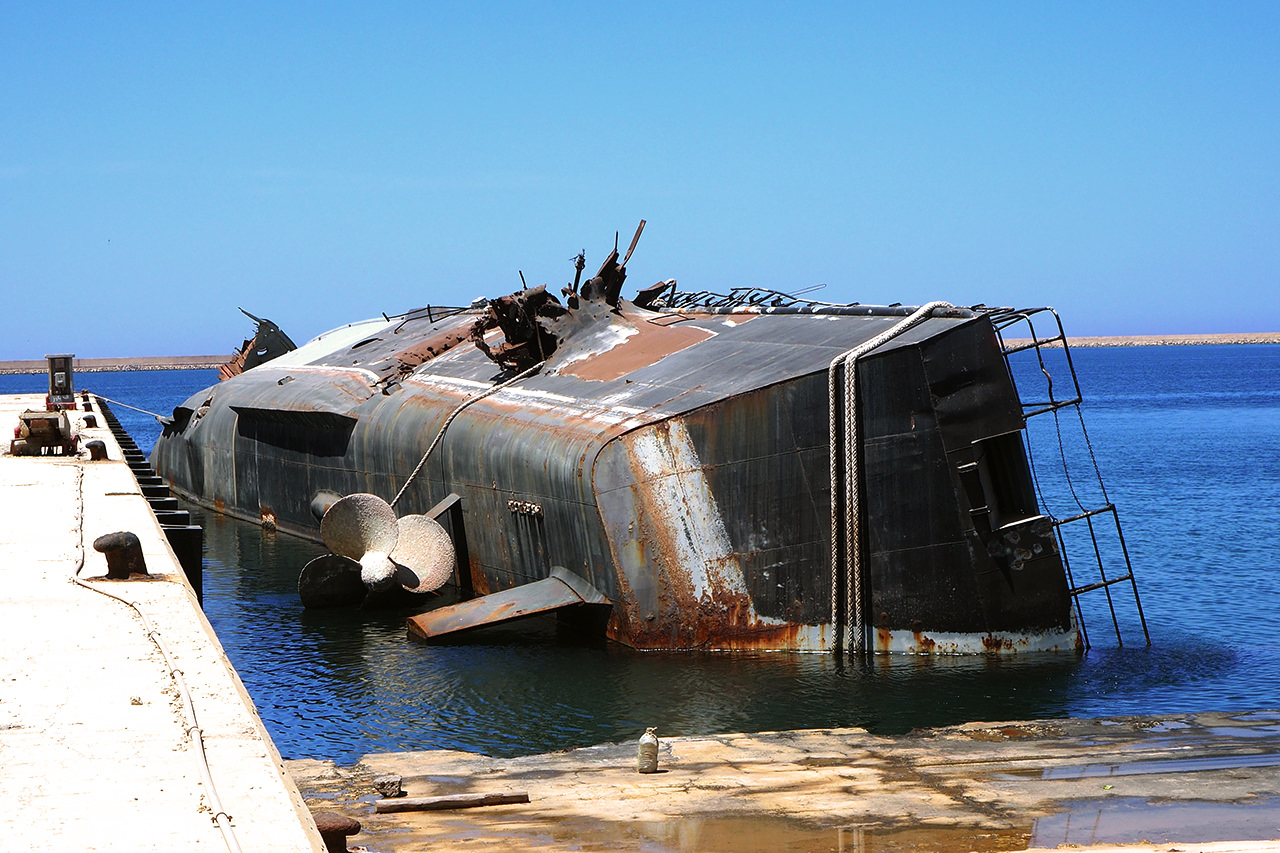
“NATO destroyed many important pieces of equipment in 2011 and damaged all Libyan infrastructure, particularly Navy infrastructure,” he said, gesturing towards the harbour stretching out behind him, where nesting birds flew through holes torn through a half-submerged warship. Listing the key targets bombed by the NATO-led coalition, including command-and-control rooms, telecom systems, and naval workshops, he added: “They left us with nothing and – it became clear – at the mercy of dangerous, heavily-armed people.”
According to the EU, the decision to build up the capacity of the Libyan Coast Guard is aimed at disrupting smuggling and trafficking activities, search-and-rescue, and improving overall security in Libyan territorial waters.
But Libya’s marine security forces say there has been no such EU support, leaving them ill-equipped to secure 1,900 kilometres of coastline and undertaking rescue operations with a mismatched fleet of loaned patrol ships, aging naval vessels that consume large quantities of fuel, and rigid inflatable boats.
None of these vessels are suitable for the job in hand and many are smaller than the dinghies the smugglers use to send migrants out to sea. The Libyan authorities also lack the safety equipment carried by NGO rescue ships: for example, navy personnel don’t have life-jackets, only ropes and a couple of lifebelts to throw to migrant boats and those in distress.
A lawless bottleneck
People-smuggling from Libya steadily increased after 2013, as security deteriorated throughout the country and the value of the Libyan dinar on the black market plummeted, wreaking havoc on the economy. The smugglers have grown in strength and aggression and are now heavily armed, often with personal militias, and boast more firepower than official Libyan security forces.
“There are still very large numbers of migrants coming from the south, all planning to cross the Mediterranean, and there is nothing in place to stop them,” said Brigadier-General Tarek Shanboor, commander of GACS, the Libyan military authority responsible for coastal security and which reports to the ministry of the interior.

“The smugglers will help them, and our maritime security forces have no weapons so can’t even get close to them,” said Shanboor. “Criminals and smugglers are increasing, confident in the knowledge that official Libyan institutions have no weapons or power to intervene.”
The head of marine operations for GACS, Lieutenant-Colonel Mahmoud Adheer, can understand why the EU was reluctant to support Libyans in 2011 as the country descended into chaos following the ouster of Gaddafi. But, seven years later, he said, “this is no longer acceptable as an excuse”.
“When a big boat sinks, everybody comes here asking us what we’ve done to stop migration, and we keep telling them our shortages of equipment prevent us from doing our job properly, but still they give us nothing. It is as if the EU has promised to give us a spaceship, but only once we’ve reached the moon.”
In the midst of an ongoing civil war with ever-changing battle lines, neither the UN-backed Government of National Accord (GNA) in Tripoli nor the democratically elected institutions in eastern Libya has control over all the territory where smugglers operate, nor over all the coastal areas from which the overcrowded and typically flimsy vessels depart across the Mediterranean.
With EU member states split on so-called “burden-sharing” and European countries offering support to rival groups and governments in Libya, it is difficult to hold any one party accountable and there is plenty of room on all sides for excuses and buck-passing.
“Europe is not united in its approach to migration through Libya, and the EU continues to doubt the ability of Libyan institutions to do their job, citing multiple governments and other Libyan problems as an excuse to limit support or even stop it altogether,” Shanboor said.
The EU maintains it is already fully committed to helping Libya through Operation Sophia as well as initiatives such as Operation Aurora, which aims for Libya to establish a fully functioning maritime rescue coordination centre by 2020. It also argues that Libya benefits from a 182-million-euro emergency EU trust fund aimed at protecting migrants and supporting local communities.
Under-resourced and powerless
As far as Ghassem, the spokesman, is concerned, the Libyan Coast Guard and naval security forces have worked diligently with the EU since 2011 – apprehending more than 80,000 migrants trying to cross the Mediterranean – only to receive very little in return.
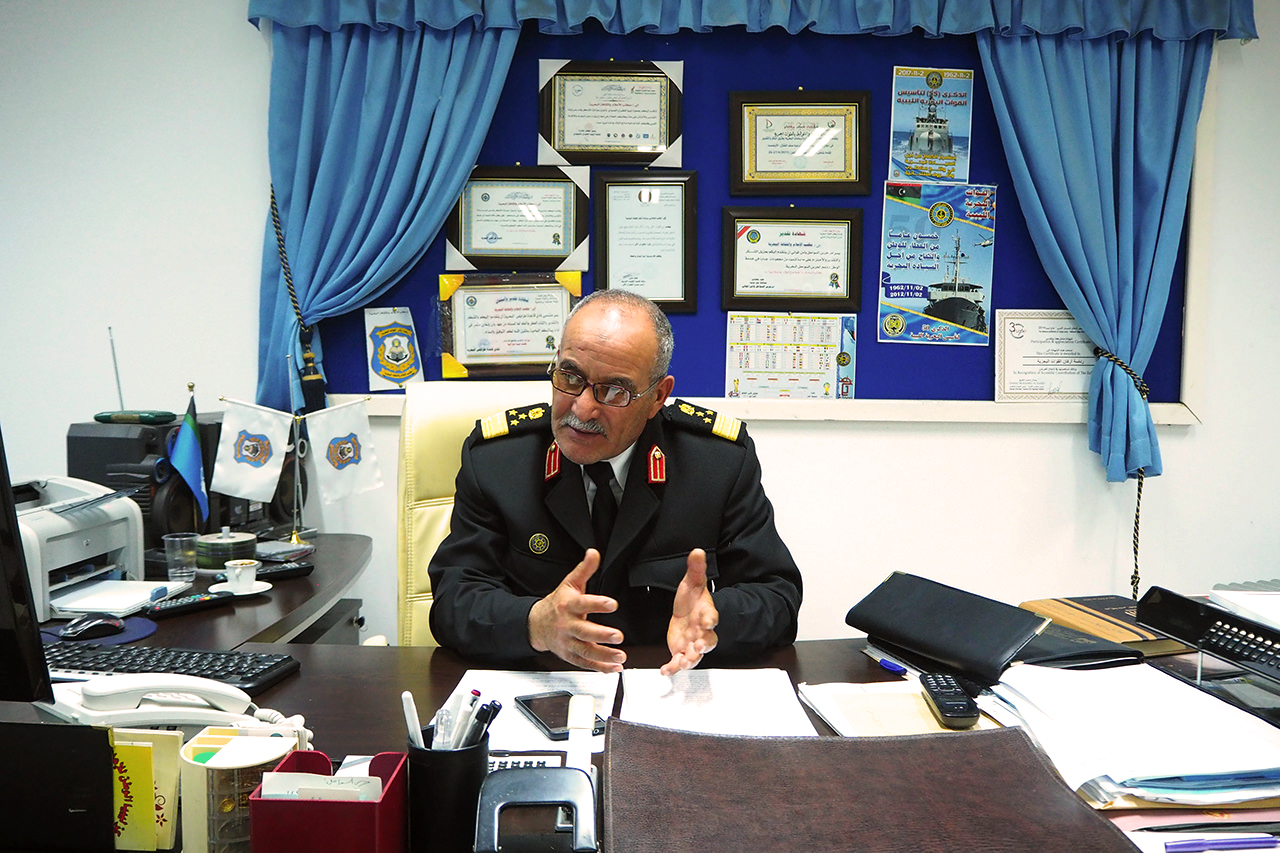
“We need boats, equipment, and ammunition to face these smugglers and to defend Libya’s territorial waters with dignity,” he said. “Our requests are modest, but they are still not being met.”
Announcing an additional 90 million euros in funding for assistance in Libya, Morocco, and Tunisia on 6 July, EU High Representative for Foreign Affairs and Safety Policy Federica Mogherini commented: "Today's new programmes will step up our work to managing migration flows in a humane and sustainable way, by saving and protecting lives of refugees and migrants and providing them with assistance and by fighting against traffickers and smugglers.
“It is our integrated approach that combines our action at sea, our work together with partner countries along the migratory routes, including inside Libya, and in the Sahel. This work has already brought results..."
EU talks on migration at the end of June – the latest bid to patch over huge differences – mentioned additional support for Libya only in passing, and only in the context of it being one of many countries of origin for migrants and refugees. Instead, the talks focused on creating new asylum processing centres in Europe, although the Italians pushed for additional centres – referred to as disembarkation platforms – in North Africa as well.
Days after the EU summit, the African Union rejected hosting such centres and decided to set up its own AU migration body to coordinate policies across the continent, amid rising opposition from countries like Libya and Morocco to “counterproductive” EU solutions.
Although part of Operation Sophia’s mandate was to disrupt smuggler networks, that has not happened, primarily because its scope is almost exclusively outside the country and its territorial waters. A 2017 UK parliamentary report, Operation Sophia: a failed mission, highlighted this and other failings. A naval mission, the report stated, is “the wrong tool to tackle irregular migration that begins onshore”.
The large EU naval presence – soon followed by a flotilla of NGO rescue ships – has also had some unintended consequences. Instead of stemming the outward flow, it initially spurred migrants and refugees on towards the coast. Libyan officials claim it encouraged thousands of additional migrants and refugees to brave the sea journey, believing a fleet of European vessels was waiting to save them.
While the EU says Operation Sophia has now reduced the numbers departing and the deaths at sea, the actual proportion of those who do attempt the voyage but end up dying has seen a recent increase.
Migrant boats also only need now travel beyond Libyan territorial waters before sending distress calls – rather than reach Italian waters – so smugglers reduce the amount of fuel on board to save money. Another objective of Sophia was to destroy the vessels the smugglers use, but this remains largely unfulfilled as the skippers of some NGO rescue boats – which have been undertaking most of the rescue operations – refuse to destroy them.
Bad press?
For Ghassem, the international media unfairly vilifies the Libyan Coast Guard.
“It’s true that sometimes our Navy guys use a rope or stick to threaten the migrants, but this is just to scare them into being quiet while we try to complete the rescue,” he said. Coast Guard staff are not allowed to carry guns, he added, explaining that five or six officers often have to control large numbers of terrified and panicking migrants who, because they don’t want to be returned to Libya, often try to overpower them.
“Film-makers with the NGOs just focus on the Libyan man with the stick and don’t show all the pushing and shoving and complete chaos behind that we are trying to get under control, and this has unfairly given the Libyan Coast Guard a bad reputation,” Ghassem said.
He showed IRIN jumpy video footage of a botched rescue attempt from November 2017, when the NGO rescue vessel Sea Watch attempted to take over an operation already underway by the Libyan Coastguard and then issued a press release blaming everything on the Libyans.
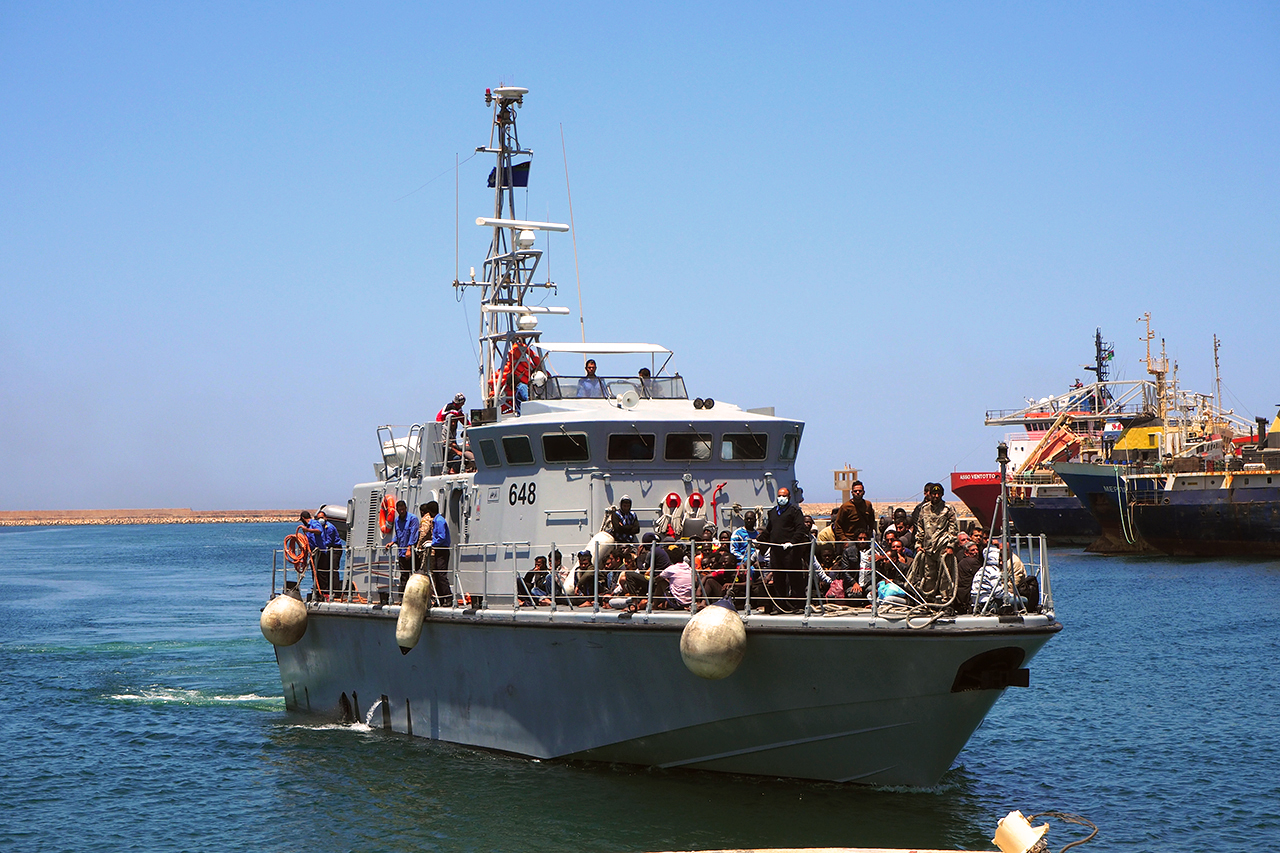
“It’s incredibly hard to do these rescues, because we’re dealing with large numbers of people who can’t swim and are panicking, each one thinking only of himself,” said Ghassem. “We try to follow a system, taking pregnant women and children first, but when we start the transfer, lots of yelling and pushing starts and sometimes my men need to scare them to stop mass panic and bring the situation under control, in order to actually be able to save them.”
Ghassem’s portrayal of the Libyan Coast Guard is one of professionalism and transparency, but institutions based outside the capital are largely beyond any government control and operate independently.
Some Coast Guard staff have been implicated in people-smuggling, with migrants who had returned to Sierra Leone telling IRIN that the same people who put them to sea later captured and imprisoned them.
Abdelrahman Milad, a senior Coast Guard official from Zuwarah, a coastal town 100 kilometres west of Tripoli, was recently named a people-smuggling kingpin in a UN investigation that froze his assets and sanctioned his travel. Ghassem confirmed that Milad was a member of the Coast Guard who has been suspended and is under investigation.
Lack of actual support
While millions of euros are being poured into NGO-led migrant assistance in Libya, hardly any funding or support is being directed towards Libya’s official maritime security institutions, Ghassem complained. He rubbished media claims that the EU had channelled £160 million into supporting the Libyan Coast Guard, saying that if the UN-backed GNA government had received such funds none had trickled down to them.
Amnesty International has slammed “shameful EU policies”, saying “European leaders spare no effort to ensure the Libyan Coast Guard intercepts as many people as possible,” and Italy and other European countries provide “equipment, including at least four speedboats,” as well as training and other support.
However, Ghassem said those four boats were loaned Italian vessels merely returned to Libya. According to Coast Guard figures, in the first four months of this year they only intercepted 403 more migrants than over the same period in 2017.
Shanboor had a similar story. “We work with the Italians and the EU but, until this moment, we have received nothing except training and the maintenance of... our own boats,” he said. “This is the reality of what it’s like for us working with the EU.”
Noting that GACS had been completely disempowered after 2011, losing most of its fleet, equipment, and its coastal headquarters, which remains occupied by a militia, he added: “We asked countries that participated in the destruction of Libya in 2011 to participate in rebuilding what they destroyed, but I’m sorry to say that they’ve virtually turned their backs on us.”
The EU has trained just 201 Libyan Coast Guard personnel, a modest figure considering GACS alone has 4,500 staff.
Several Libyan officials said the training was too heavily focused on human rights issues rather than more useful instruction on things like the limited communications equipment – during rescue operations most Coast Guard personnel have to rely on their own mobile phones, which have little or no network coverage at sea.
“Many things are more important than training, like actual practical support,” complained one of the most senior officials in Libya’s Anti-Illegal Immigration Authority, or AIIA, speaking on condition of anonymity.
Why the drop in numbers?
According to the senior AIIA official, EU policies have had no impact on reducing the number of migrants arriving in Europe. He said the drop was largely the result of a major Libyan crackdown last October on smuggling networks in the coastal town of Sabrata, which, largely outside government control since 2015, had become a primary migrant departure point.
This was reportedly less of a bust and more of a mass migrant arrest operation, facilitated by the outbreak of violence between rival smuggling gangs. Some sources have claimed the operation was the result of a deal between the Italian government and some key Sabrata smugglers.
As smugglers fled, the Libyan authorities rolled in and rescued/arrested more than 12,000 migrants held by smugglers in appalling conditions awaiting better weather for the sea crossing. At the time, UNHCR put the number at 14,500.
Another AIIA official in the nearby town of Zawia told IRIN that smugglers in other areas of the Libyan coast – Zuwarah, Zawia, Gharian, and Khoms – had continued their operations and, just six months after the bust, Sabrata smugglers were back at work.
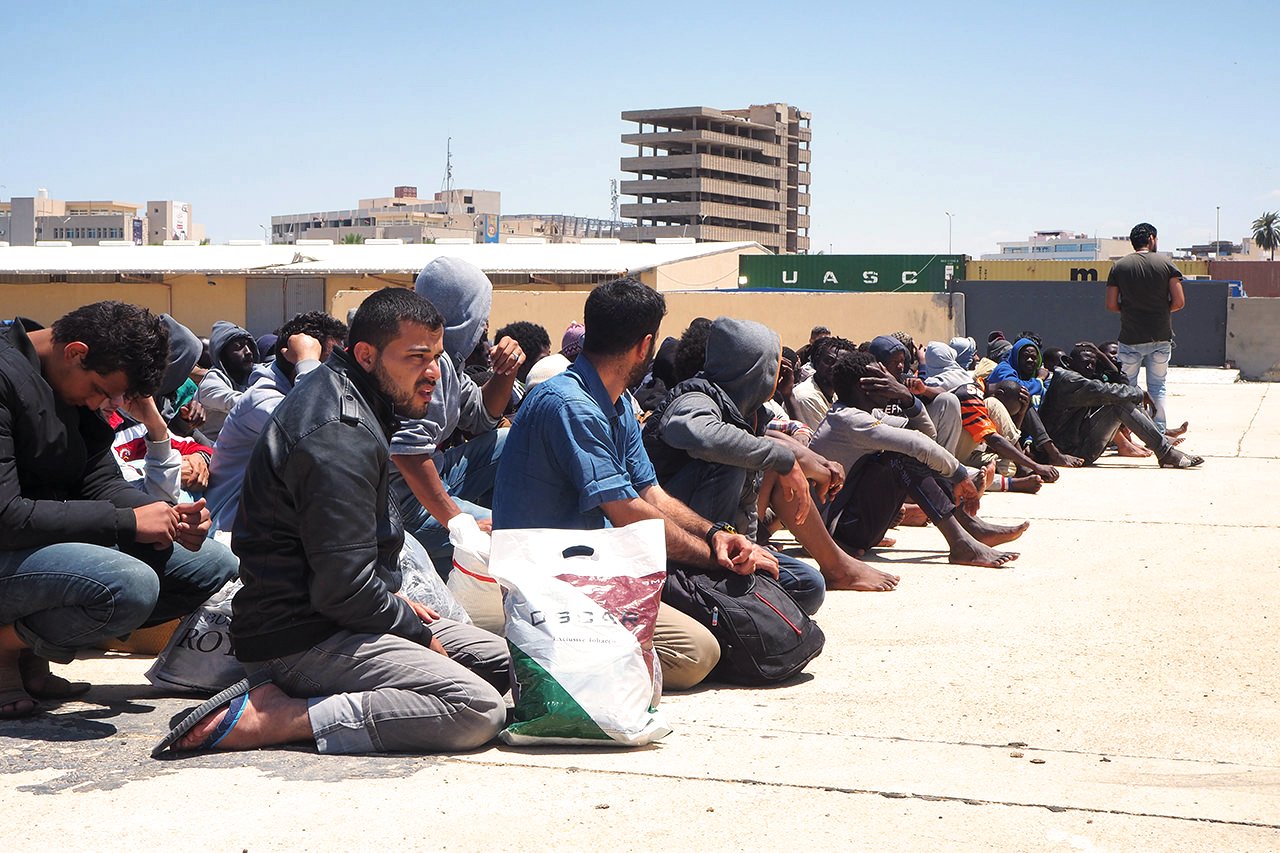
Libyan officials also put the reduction in the number of migrants crossing to Europe from Libya recently down to an outbreak of violence earlier this year between rival tribes in Sebha, a people-smuggling hub in the country’s south, Libyan officials say. The five-month conflict made it largely impossible for migrants to cross through Sebha.
“The war in Sebha is one of the main reasons for the decrease in migrants arriving in Europe,” the head of a migrant detention centre near Tripoli’s airport, Captain Wajidi al-Bashir al-Montassir, told IRIN.
Al-Montassir explained that most migrants arrested this year had taken an alternative route, travelling from Sebha to Algeria and re-entering Libya across the western border. “This doesn’t stop them reaching the coast, it only slows them down. Before, it took an average migrant two months to reach the coast, but recently it has taken six to eight months because of the Algeria diversion.”
Major Mohammed Tamimi, commander of a key checkpoint just north of Sebha, confirmed that fighting in Sebha left smugglers unable to use their usual routes. Before it erupted, smugglers operated openly under the watch of security forces, with seven to 10 large vehicles packed with migrants passing his checkpoint most days. With few weapons and no functioning detention centres in the south, his forces have been powerless to intercept the vehicles for several years.
“Just 200 metres from my checkpoint, there’s a smugglers’ centre where they gather migrants for the next stage of their journey, but we can’t go near them because they are very well armed,” he said. “We just watch them, but can do nothing.”
Summer numbers set to rise
With the impact of the Sabrata bust, now eight months old, fading and the Sebha route starting up again after an uneasy truce was reached in early May, Libyan officials believe the number of migrants and asylum seekers making their way to the coast will rise again soon.

“Figures connected to operations in the sea or arrivals in Europe are not representational of the actual migrant situation here because what happens on the coast has no effect on the numbers of migrants entering Libya,” said Tamimi, adding that AIIA officials working in Libya’s south had seen no indications that numbers entering Libya had decreased.
Two Libyan smugglers working the main central desert Niger-Libya route told IRIN that the numbers of migrants they transport have remained unchanged during the last three years. They estimated that 1,200 migrants continue to enter Libya every week via that route alone, a figure that excludes other routes from Sudan and southern Algeria.
The Libyan Coast Guard is currently undertaking almost daily rescues at sea but, with limited capacity, it is only able to intercept around two vessels per day.
For Adheer, head of GACS’s marine operations, the build-up in Libya’s coastal bottleneck means the numbers of migrants attempting to cross the Mediterranean is bound to rise as the summer continues. “According to our intelligence, there are around one million migrants currently in Libya, ready and waiting to cross the sea,” he added.
tw/ag
Destination Europe: Misery and misunderstandings
In the next instalment, Westcott turns the spotlight on the migrants and refugees themselves. Libya has gained dubious renown as a hub for irregular immigration towards Europe but, beyond the headlines and statistics, what are the personal realities, and how are UN and EU efforts to help, protect, and return migrants and resettle refugees while reducing the migrant flow really working out?
Read the other instalments: Homecoming, Evacuation, Frustration, Desperation, Deportation, Demoralised, Misery and misunderstanding part 1 and part 2, and Overlooked.
